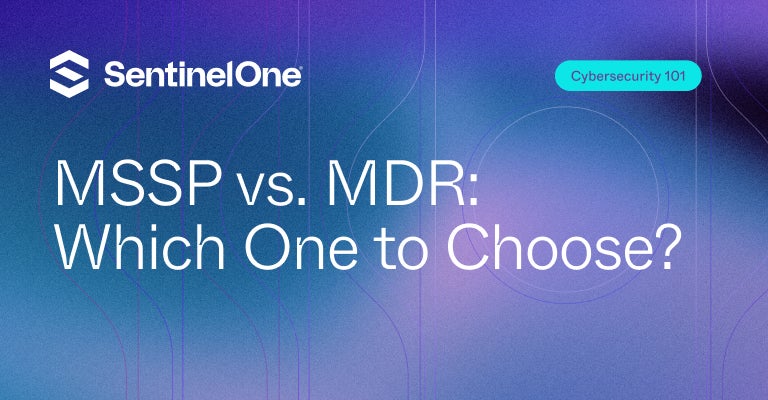Reports from findings suggest that up to 60% of businesses have adopted MSSP for round-the-clock monitoring. There’s still high demand for MDR as well as adoption rates for this service have risen by 45%. Here’s the difference: MSSP helps you manage and monitor security devices. MDR on the other hand goes even further by providing access to advanced threat detection and response.
So, let’s take a look at what both options bring to the table
 What Is MDR (Managed Detection and Response)?
What Is MDR (Managed Detection and Response)?
MDR (Managed Detection and Response) is a security service that helps IT professionals better identify and mitigate threats. MDR focuses on security through proactive defense setups backed with real-time incident handling.
It uses artificial intelligence and machine learning, along with expert analysis, to identify cyber threats in real-time. The framework is also designed to take security measures against any such threat.
Unlike traditional security measures, which are slow and inefficient, MDR offers continuous monitoring and immediate response to security and cyber breaches:
- MDR services include constant surveillance, scouting for threats, and quick responses. As per an IDC report, 64% of organizations are making faster intrusion detection using MDR
- MDR is the go-to service today because it quickly detects attacks that may bypass conventional system defenses
- Another reason MDR is popular is that companies use it to improve their cybersecurity resilience and protect the ecosystem
Pros of Leveraging MDR
According to Gartner, by 2025, about 50% of organizations will adopt MDR services for threat monitoring, detection, and response with built-in containment capabilities. MDR strengthens an organization’s defenses with key features that go beyond traditional security.
1. Advanced Threat Detection
MDR specializes in identifying complex threats like advanced persistent threats, fileless malware, zero-day exploits, and evasive malware—often undetected by conventional security measures.
2. 24/7 Expert Support
MDR includes out-of-hours support to keep an eye on your systems for infiltrations or exploits at all times of the day.
3. Reduced Burden on Internal Security Teams
MDR providers take on the day-to-day security tasks, freeing up internal IT teams to focus on more strategic initiatives. This not only improves team productivity but also enhances the organization’s overall security.
Cons of using MDR
While MDR services offer significant advantages, they come with potential downsides that decision-makers have to weigh carefully:
1. Comes at a High Cost
Costs of fees for additional features, charges for installation, and payments for periodic subscriptions will most probably be experienced. For smaller organizations, MDR services can come at quite a cost. This makes the investment particularly challenging for those with limited budgets.
2. The Company May Lose Control
Moving responsibility toward an MDR provider can limit the extent to which an organization can control its security operations, which can be problematic for companies that have very strict internal structures.
3. May Come with Integration Challenges
A handicap to consider is the inability to link the current stack with the new system resulting in additional time and expenses. Integration bumps with the existing systems are a common occurrence making adequate preparation before the process highly desirable.
A Four-Time Leader
See why SentinelOne has been named a Leader four years in a row in the Gartner® Magic Quadrant™ for Endpoint Protection Platforms.
Read Report
What Is MSSP (Managed Security Service Provider)?
An MSSP (Managed Security Service Provider) delivers cybersecurity solutions for organizations seeking comprehensive security management. MSSPs offer services like threat detection, real-time response, systems management, and 24/7 monitoring to ensure continuous protection of an organization’s IT infrastructure.
- Like MDR, MSSPs offer 24/7 monitoring, but they also go beyond by tailoring their services to fit the unique needs of a business. They scale with you, growing as your organization grows
- MSSPs bring advanced security practices to the table. You get to focus on running your business, while they quietly handle the risks in the background
Pros of MSSPs
MSSPs offer a range of benefits to enhance an organization’s security while providing operational and financial advantages:
1. MSSPs Provide Expertise and Experience
MSSPs provide access to notable cybersecurity experts with extensive experience in threat detection and response. This expertise ensures that organizations benefit from the latest security practices and technologies.
2. They are Cost-Efficient
Small to medium businesses spend 5–20% of their IT budget on security. Outsourcing to an MSSP provider can be more cost-effective than building and maintaining an in-house security team for threat detection. It eliminates the need for upfront investments in security tools and reduces the overhead of hiring full-time staff.
3. Offer 24/7 Monitoring
MSSPs offer continuous monitoring and support to organizations, ensuring potential security threats are detected and addressed around the clock. This constant vigilance helps minimize the risk of security breaches and reduce response times to cyber threats.
Cons of MSSPs
MSSPs have potential drawbacks, too. Let us discuss the disadvantages to figure out if the approach aligns with your security goals and operational structure:
1. They Reduce Control Within Organizations
This is arguably the best part regarding the decision to use an MSSP but is a liability as it takes away control over how to implement the threat prevention policies in an organization. This can also make it hard to fit external policies with internal security practices.
2. Integration of New Systems and Compatibility Issues
Bringing an MSSP into your existing IT environment isn’t always seamless. Compatibility issues may arise, potentially requiring significant time and resources to ensure smooth operation with the current infrastructure.
3. MSSPs have a Variable Service Quality
A 2023 Ponemon Institute study found that 63% of organizations using MSSPs experienced a security incident that the MSSP failed to detect or prevent.
It suggests that the quality of MSSP services can vary significantly between providers, affecting the effectiveness of security measures. Organizations must carefully evaluate and select an MSSP provider with great precision to ensure they meet the required security standards and deliver reliable support to the company to protect their digital assets.
Critical Differences: MSSP vs MDR
The following table outlines the critical differences across the various aspects of MSSP vs MDR, helping decision-makers choose the solution that best fits their security needs and organizational structure:
| Aspects | MSSP | MDR |
|---|---|---|
| Scope of services | MSSPs offer a broad range of security management services, including monitoring, compliance, and vulnerability management. | MDR focuses specifically on threat detection, incident response, and threat hunting. |
| Proactive vs. reactive security | MSSPs provide a mix of both proactive and reactive security measures. | MDR emphasizes proactive threat detection and response to emerging threats. |
| Response capabilities | MSSPs typically offer standard incident response and management services. | MDR provides advanced, rapid response to active threats and ongoing attacks. |
| Expertise Level | MSSPs deliver general security expertise across various domains. | MDR specialists are highly skilled in advanced threat detection and mitigation. |
| Integration complexity | MSSP solutions may integrate with existing systems but can involve complex setups. | MDR often requires tight integration with existing security infrastructure for effective detection and response. |
The Relationship Between MSSP And MDR
Both MSSP vs MDR services have different areas where they shine and excel at improving your security posture, but they both combine better to create a solid cybersecurity strategy.
According to a 2022 Forrester report, organizations using MDR services saw 85% fewer breaches compared to those relying solely on traditional MSSPs.
This collaboration gives organizations confidence in tackling complex security challenges and maintaining a strong, resilient defense. Here’s a quick overview of the key benefits:
- MSSPs handle essential security tasks such as continuous monitoring, threat assessments, and compliance management
- MSSPs ensure general security by managing firewalls, intrusion detection, and vulnerability assessments
- MDR services excel in identifying and neutralizing sophisticated threats before they escalate
- MDR provides real-time incident response, minimizing potential damage from cyber attacks
- Organizations leverage MSSPs for foundational security while integrating MDR for advanced threat management
- Combining MSSPs and MDR results in a multi-layered defense, reducing the risk of breaches
- This approach enhances overall cybersecurity, aligning with industry best practices and standards
- The collaboration between MSSPs and MDR supports proactive security measures, ensuring continuous protection
MSSP vs MDR: Key Benefits
MDR and MSSP are top choices for businesses aiming to protect their digital assets. Each offers distinct advantages:
1. Advanced Threat Detection
MDR focuses on proactive threat hunting and using advanced analytics to detect sophisticated and emerging threats. MSSPs, on the other hand, provide broad security monitoring and general management for a more comprehensive security approach.
2. Specialized Response
MDR offers rapid, expert-level responses with in-depth threat analysis and mitigation, whereas MSSPs focus more on standard incident management and response.
3. Enhanced Focus on Threats
MDR targets complex security incidents, while MSSPs cover a wider range of services, including compliance and vulnerability management.
Discover Unparalleled Endpoint Protection
See how AI-powered endpoint security from SentinelOne can help you prevent, detect, and respond to cyber threats in real time.
Get a DemoMDR Vs MSSP: Use Cases
Choosing between MDR and MSSP largely depends on your organization’s specific security needs, threat landscape, and operational requirements.
The following table highlights critical use cases for each service, helping organizations identify which solution aligns best with their cybersecurity goals and challenges:
| MDR | MSSP |
|---|---|
| Complex threat environments MDR is ideal for organizations facing sophisticated cyber threats and needing advanced detection and response capabilities. | Broad security management MSSPs suit businesses requiring comprehensive security management services, including monitoring, compliance, and vulnerability assessments within the different systems. |
| Enhanced incident responses MDR benefits companies that need rapid, expert intervention for active security incidents. | Generic incident responses MSSPs offer general incident response and support. |
FAQs
MSSPs monitor and manage security devices for threat detection, while MDRs focus on proactive threat hunting and real-time incident response.
MSSPs are generally more cost-effective due to their broader, less specialized services compared to the advanced, targeted offerings of MDRs.
Organizations can use MSSP and MDR to benefit from comprehensive security management and advanced threat detection.
Yes, MSPs (managed service providers) manage general IT services, while MSSPs focus on managing and securing an organization’s cybersecurity.
An MSSP is an external provider of security services, while a SOC (security operations center) is typically an in-house team dedicated to monitoring and responding to security incidents.

